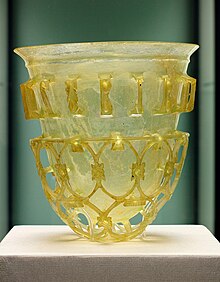
Back تاريخ الزجاج Arabic কাচের ইতিহাস Bengali/Bangla Hanes gwydr Welsh Geschichte des Glases German Vidrio#Historia del vidrio Spanish تاریخ شیشهگری Persian Histoire du verre French Povijest stakla Croatian Ապակու պատմություն Armenian ガラス年表 Japanese

The history of glass-making dates back to at least 3,600 years ago in Mesopotamia. However, most writers claim that they may have been producing copies of glass objects from Egypt.[1] Other archaeological evidence suggests that the first true glass was made in coastal north Syria, Mesopotamia or Egypt.[2] The earliest known glass objects, of the mid 2,000 BCE, were beads, perhaps initially created as the accidental by-products of metal-working (slags) or during the production of faience, a pre-glass vitreous material made by a process similar to glazing.[n 1] Glass products remained a luxury until the disasters that overtook the late Bronze Age civilizations seemingly brought glass-making to a halt.
Development of glass technology in India may have begun in 1,730 BCE.[3]
From across the former Roman Empire, archaeologists have recovered glass objects that were used in domestic, industrial and funerary contexts. Anglo-Saxon glass has been found across England during archaeological excavations of both settlement and cemetery sites. Glass in the Anglo-Saxon period was used in the manufacture of a range of objects, including vessels, beads, windows, and was even used in jewellery.
- ^ "Glass making may have begun in Egypt, not Mesopotamia Artifacts from Iraq site show less sophisticated technique, color palette". 2016-11-22. Retrieved 2016-11-25.
- ^ "Glass Online: The History of Glass". Archived from the original on April 15, 2011. Retrieved 2007-10-29.
- ^ Gowlett, J.A.J. (1997). High Definition Archaeology: Threads Through the Past. Routledge. ISBN 0-415-18429-0.
Cite error: There are <ref group=n> tags on this page, but the references will not show without a {{reflist|group=n}} template (see the help page).
© MMXXIII Rich X Search. We shall prevail. All rights reserved. Rich X Search